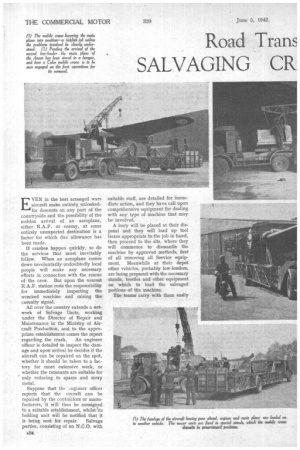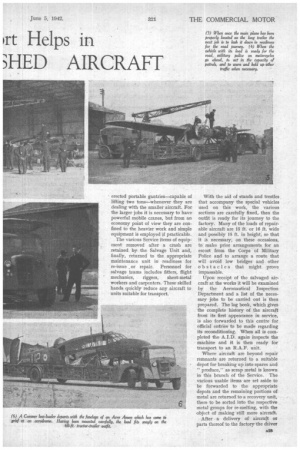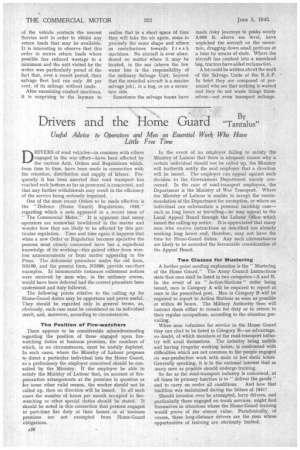Road Trans Irt Helps in SALVAGING CR. 3FIED AIRCRAFT
Page 26

Page 27

Page 28

If you've noticed an error in this article please click here to report it so we can fix it.
EVEN id the best arranged wars aircraft make entirely_ unlockedfor descents on any part of the countryside and the possibility of the sudden arrival of an aeroplane, either R.A.F. or enemy, at some entirely unexpected destination is a factor for which due allowance has been made.
If crashes happen quickly, so do the services that must inevitably follow. When an aeroplane comes down involuntarily undoubtedly local people will make any necessary efforts in connection with the rescue of the crew. But upon the nearest R.A.F. station rests the responsibility for immediately inspecting the wrecked machine and raising the casualty signal.
All over the country extends a network of Salvage Units, working under the Director of Repair and Maintenance in the Ministry of Aircraft Production, and to the appropriate establishment comes the report regarding the crash. An engineer officer is detailed to inspect the damage and upon arrival he decides if the aircraft can be repaired on the spot, whether it should be taken to a factory for more extensive work, or whether the remnants are suitable for only reducing to spares and scrap metal.
Suppose that the engineer officer reports that the iircraft can be repaired by the contractors or manufacturers, it will then be consigned to a suitable establishment, whilst sits holding unit will be notified that it
is being sent for repair. Salvage parties, consisting of an N.C.O. with suitable staff, are detailed for immediate action, and they have call upon comprehensive equipment for dealing with any type of machine that may be involved.
A lorry will be placed at their disposal and they will load up tool boxes appropriate to the job in hand, then proceed to the site, where they will commence to dismantle the machine by approved methods, first of all removing all Service equipment. Meanwhile at their depot other vehicles, probably low-loaders, are being prepared with the necessary stands, trestles and other equipment on which to load the salvaged potions of the machine.
The teams carry with them easily • erected portable gantries—capable of lifting two tons—whenever they are dealing with the smaller aircraft. For the larger jobs it is necessary to have powerful mobile cranes, but from an economy point of view they are confined to the heavier work and simple equipment is employed if practicable.
The various Service items of equipment removed after a crash are retained by the Salvage Unit and, finally, returned to the appropriate maintenance unit in readiness for re-issue _or repair. Personnel for salvage teams includes fitters, flight mechanics, riggers, sheet-metal workers and carpenters. These skilled hands quickly reduce any aircraft to units suitable for transport. With the aid of stands and trestles that accompany the special vehicles used on this work, the various sections are carefully fixed, then the outfit is ready for its journey to the factory. Many of the loads of repairable aircraft are 15 ft. or 16 ft. wide and possibly 15 ft. in height, so that it is necessary, on these occasions, to make prior arrangements for an escort from the Corps of Military Police and to arrange a route that will avoid low bridges and other obstacles that might prove impassable.
Upon receipt of the Salvaged aircraft at the works it will be examined by the Aeronautical Inspection Department and a list of the necessary jobs to be carried out is then prepared. The log book, which gives the complete history of the aircraft from its first appearance in service, is also forwarded to this centre for official entries to be made regarding its reconditioning. When all is completed the A.I.D. again inspects the machine and it is then ready for transport to an R.A.F. unit.
Where aircraft are 'beyond repair remnants are returned to a suitable depot for breaking up into spares and " produce," as scrap metal is known in this branch of the Service. The various usable items are set aside to be forwarded to the appropriate depots and the remaining portions of metal are returned to a recovery unit, there to be sorted into the respective metal groups for re-melting, with the object of making still more aircraft.
After a delivery of aircraft or parts thereof to the factory the driver of the vehicle contacts the nearest Service unit in order to obtain any return loads that may be available, It is interesting to observe that this order to secure return loads where possible has reduced wastage to a minimum and the unit visited by the writer was particularly proud of the fact that, over a recent period, -their salVage fleet had run only .06 per cent, of its mileage without loads.
After examining crashed machines, it is surprising to the layman to realize that in a short space of time they will take the air again, some in precisely the same shape and others as contributions towards f resh machines. No aircraft is ever abandoned no matter where it. may be located, in the sea (above the low water line is the responsibility of the ordinary Salvage Unit; beyond that the stranded aircraft is a marine salvage job), in a bog, or on a mountain side.
Sometimes the salvage teams have made risky journeys to peaks nearly 3,000 ft. above sea level, have unpicked the aircraft on the mountain, dragging down small portions at a time by means of sleds. Where the aircraft has crashed into a moorland hog, tractors have aided reclamation.
A lot could be written about the work of the Salvage Units of the R.A.F. In brief they are composed of personnel who see that nothing is wasted and they do not waste things themselves—not even transport mileage.




















































